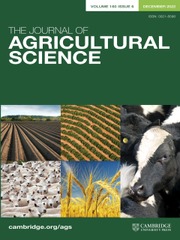No CrossRef data available.
Article contents
Impact of rehydration with cactus pear on the fermentation profile, chemical composition and bacterial microbiome of corn grain silage
Published online by Cambridge University Press: 24 January 2025
Abstract
The objective of this study was to assess the fermentation profile, chemical composition, aerobic stability and taxonomic diversity of corn grain silages rehydrated with water or cactus pear. Two rehydration methods were tested: corn grain silage rehydrated with water (CW) and corn grain silage rehydrated with cactus pear (CCP), each subjected to four opening times (30, 60, 90 and 120 days). The experiment employed a 2 × 4 factorial completely randomized design (two rehydration methods and four opening times) with four repetitions, units 32 experimental units. pH values were higher in water-rehydrated corn grain silage compared to cactus pear-rehydrated silage at 60 (average of 4.78 and 4.33) and 90 days (average of 4.33 and 3.83). For NH3-N, CW surpassed CCP at 30 days (average of 0.73% and 0.63%) and 60 days (average of 1.09% and 0.74%), respectively. Regarding rehydration, CCP had a higher dry matter (DM) content at 30 and 60 days, while CW showed the highest DM content at 90 and 120 days. Initially, the microbiota of CW and CCP treatments differed, primarily in the abundance of the Weissella genus, more abundant in CCP. However, from 30 to 120 days, microbiotas in all treatments became taxonomically similar, with no significant differences. Both silage experienced an increase in bacteria of the Lactobacillus genus. The use of cactus pear for rehydration in ensiling rehydrated corn grain is viable, showing superior results for fermentation profile and aerobic stability compared to water rehydration. It is recommended to open the silo after 60 days of fermentation.
- Type
- Crops and Soils Research Paper
- Information
- Copyright
- Copyright © The Author(s), 2025. Published by Cambridge University Press



